
Louis Arthur Johnson was an American politician and attorney who served as the second United States Secretary of Defense from 1949 to 1950. He was the Assistant Secretary of War from 1937 to 1940 and the 15th national commander of the American Legion from 1932 to 1933.

The Distinguished Flying Cross (DFC) is a military decoration of the United States Armed Forces. The medal was established on July 2, 1926, and is currently awarded to any persons who, after April 6, 1917, distinguish themselves by single acts of heroism or extraordinary achievement while participating in aerial flight. Both heroism and extraordinary achievement are entirely distinctive, involving operations that are not routine. The medal may be awarded to friendly foreign military members in ranks equivalent to U.S. Pay Grade of O-6 and below, in actual combat in support operations.
The National Defense Service Medal (NDSM) is a service award of the United States Armed Forces established by President Dwight D. Eisenhower in 1953. It was awarded to every member of the U.S. Armed Forces who served during any one of four specified periods of armed conflict or national emergency from June 27, 1950 through December 31, 2022. Combat or "in theater" service is not a requirement for the award.
The Navy Occupation Service Medal is a military award of the United States Navy which was "Awarded to commemorate the services of Navy, Marine Corps and Coast Guard personnel in the occupation of certain territories of the enemies of the United States during World War II" and recognized those personnel who participated in the European and Asian occupation forces during, and following World War II. The medal was also bestowed to personnel who performed duty in West Berlin between 1945 and 1990.
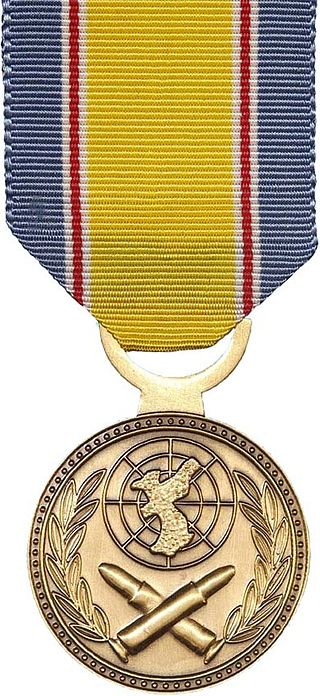
The Korean War Service Medal, also known as the Republic of Korea War Service Medal (ROKWSM), is a military award of South Korea which was first authorized in December 1950.

USS Haven (AH-12) was the lead ship of her class of hospital ships built for the U.S. Navy during World War II. Laid down as SS Marine Hawk, she was transferred from the Maritime Commission for conversion to a hospital ship, and served in that capacity through the end of the war. She was redesignated APH-112 in June 1946 for participation in Operation Crossroads, returning to her original AP-12 designation in October 1946. Haven participated in the Korean War and eventually ending her military career acting as a floating hospital in Long Beach, California. She was later converted to a chemical carrier and scrapped in 1987.
The Presidential Unit Citation is a military unit award of the government of Republic of Korea that may be presented to South Korean military units and foreign military units for outstanding performance in defense of the Republic of Korea. In recognition of allied military service to South Korea during the Korean War, all United States military departments were authorized the unit award for that period.
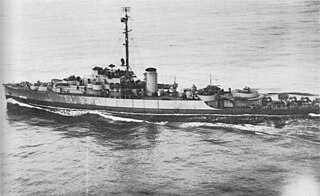
USS Gloucester (PF-22), a Tacoma-class frigate in commission from 1943 to 1945, was the second ship of the United States Navy to be named for Gloucester, Massachusetts. She later served in the Soviet Navy as EK-26 and in the Japan Maritime Self-Defense Force as JDS Tsuge (PF-12) and JDS Tsuge (PF-292).
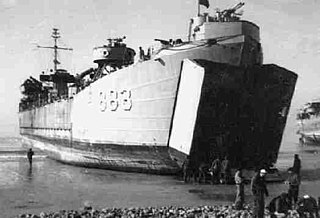
USS La Moure County (LST-883) was an LST-542-class tank landing ship built for the United States Navy during World War II. Named after LaMoure County, North Dakota, she was the first of two U.S. naval vessels to bear the name.

USS Bolster (ARS-38) was a Bolster-class rescue and salvage ship acquired by the U.S. Navy during World War II and remained in service during the Korean War and the Vietnam War. Her task was to come to the aid of stricken vessels.

USS Hewell (AG-145/AKL-14) was a Camano-class cargo ship constructed for the U.S. Army as FS-391 shortly before the end of World War II. FS-391 operated with a U.S. Coast Guard crew in the Southwest Pacific area. The ship was acquired by the U.S. Navy in 1948. She was configured as a transport and cargo ship and served with the U.S. Pacific Fleet – including highly decorated service during the Korean War – until decommissioned in 1955.

USS Sussex (AK-213) was an Alamosa-class cargo ship that was constructed for the US Navy during the closing period of World War II. She was retained by the Navy for post-war service, including that in the Korean War theatre where she earned three battle stars and then returned home for deactivation.

USNS Sgt. Andrew Miller (T-AK-242) was built as Victory ship SS Radcliffe Victory, a Boulder Victory-class cargo ship, built at the end of World War II. She served during the war and its demilitarization as a commercial cargo vessel operated by American West African Lines under charter with the Maritime Commission and War Shipping Administration. From 1946 to 1950, she served the US Army as a transport named USAT Sgt. Andrew Miller. In 1950, she was acquired by the US Navy and assigned to the Military Sea Transportation Service (MSTS). In 1981 she ended her career and was placed into reserve.

The United States Air Force in South Korea is composed of units assigned to Pacific Air Forces Seventh Air Force. The mission of the personnel, equipment and aircraft is to deter, protect and defend the Republic of Korea from attack from the Democratic People's Republic of Korea (DPRK) or more commonly known as North Korea.
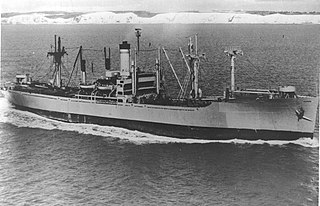
USNS Lt. George W. G. Boyce (T-AK-251) was a Boulder Victory-class cargo ship built for the U.S. Maritime Commission during the final months of World War II.

USS Wantuck (APD-125) was a United States Navy high-speed transport in commission from 1944 to 1957.

USS Horace A. Bass (DE-691/APD-124/LPR-124) was a United States Navy high-speed transport in commission from 1944 to 1969.

USS Gardiners Bay (AVP-39) was a United States Navy seaplane tender in commission from 1945 to 1958 that saw service in the latter stages of World War II and in the Korean War. After her decommissioning, she was transferred to Norway, and she served in the Royal Norwegian Navy as the training ship HNoMS Haakon VII (A537) from 1958 to 1974.
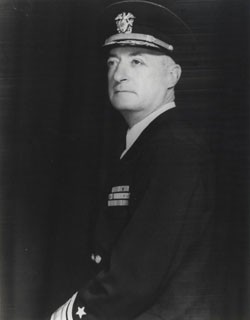
James Henry Doyle was a vice admiral in the United States Navy. During the Korean War, he commanded the U.S. Navy, Marine, and Army forces of Amphibious Group 1, and was personally responsible for the execution of the amphibious phase of the Battle of Inchon in 1950. Admiral Doyle’s naval attack force put 13,000 Marines ashore on a coastline, together with all their heavy weapons and equipment. USS Doyle was named in his honor.

Henry Pierson Crowe was a Marine of World War I, the Banana Wars, World War II, and the Korean War.

















